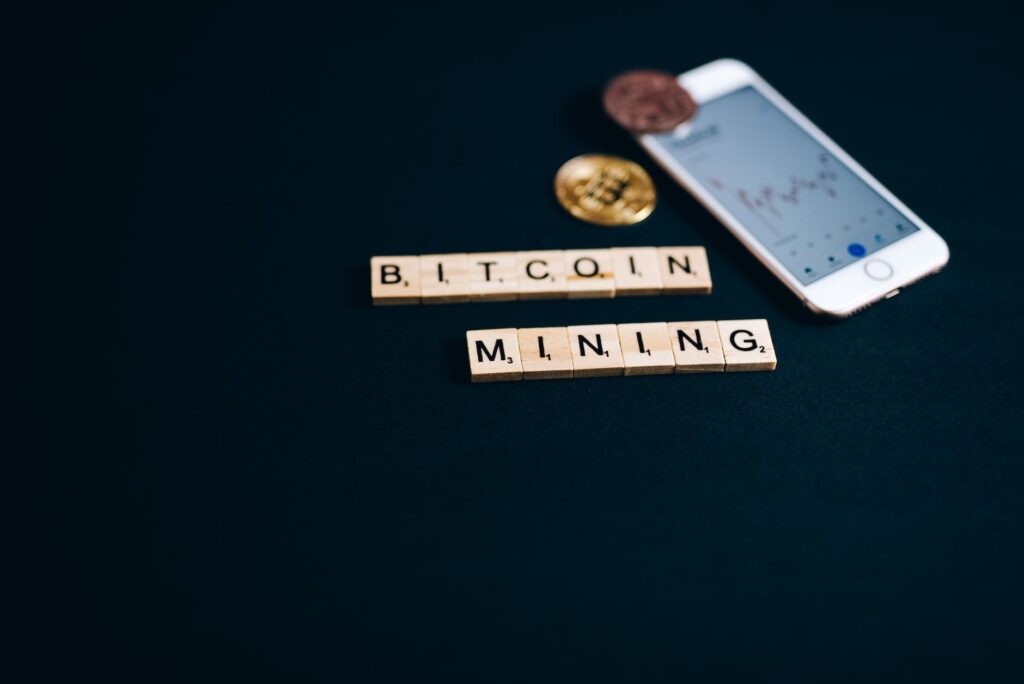Bitcoin-Schürfen: Ein Überblick
Um die Rolle von Mining Pools in Bitcoin Bergbau, beginnen wir mit einer kurzen Einführung in Bitcoin-Schürfen selbst.
Einführung in das Bitcoin-Mining
Bitcoin-Mining ist der Prozess der Validierung und des Hinzufügens neuer Transaktionen zur Bitcoin-Blockchain. Miner nutzen leistungsstarke Computer, um komplexe mathematische Probleme zu lösen, die das Netzwerk sichern und Transaktionen bestätigen. Im Gegenzug für ihre Bemühungen werden die Miner mit neu geprägten Bitcoins belohnt.
Die Rolle von Mining Pools beim Bitcoin Mining
Mit zunehmender Popularität von Bitcoin wurde das Mining immer wettbewerbsintensiver. Einzelne Miner fanden es schwierig, Blöcke alleine zu schürfen, da die erforderliche Rechenleistung sehr hoch war und die Wahrscheinlichkeit, einen Block erfolgreich zu schürfen, mit der Zeit immer geringer wurde. An dieser Stelle kommen Mining-Pools ins Spiel.
Bitcoin-Mining-Pools sind Gruppen von Minern, die ihre Ressourcen und Rechenleistung zusammenlegen, um ihre Chancen auf ein erfolgreiches Mining von Blöcken zu erhöhen. Durch die Bündelung ihrer Ressourcen können die Miner gemeinsam komplexe mathematische Probleme effizienter lösen und die Belohnungen unter den Teilnehmern auf der Grundlage ihres Beitrags verteilen.
Mining-Pools arbeiten in der Regel mit einem Reward-Sharing-System, bei dem die Belohnungen unter den Minern auf der Grundlage der Arbeit verteilt werden, die sie zum Finden eines Blocks beitragen. Dies ermöglicht es den Minern, konsistente und vorhersehbare Gewinne zu erzielen, selbst wenn ihre individuelle Mining-Leistung relativ gering ist.
Der Beitritt zu einem Mining-Pool ermöglicht es Minern, die Herausforderungen zu überwinden, die mit dem Solo-Mining verbunden sind, wie z. B. die hohen Anfangskosten für Mining-Ausrüstung und die Ungewissheit, ob sie eine Belohnung erhalten. Mining-Pools bieten einen leichteren Einstieg für Personen, die am Bitcoin-Mining teilnehmen möchten.
Um den richtigen Mining-Pool zu wählen, sollten Miner Faktoren wie Poolgröße, Hash-Rate-Verteilung, Gebühren, Belohnungsstruktur, Sicherheit und Reputation berücksichtigen. Jeder Pool kann unterschiedliche Gebührenstrukturen und Auszahlungsmechanismen haben, daher ist es wichtig, diese Aspekte zu bewerten, bevor man eine Entscheidung trifft.
Indem sie einem Mining-Pool beitreten, können Miner ihre Chancen auf gleichbleibende Belohnungen erhöhen und zur Sicherheit und Dezentralisierung des Bitcoin-Netzwerks beitragen. Es ist wichtig zu beachten, dass Mining-Pools zwar Vorteile bieten, aber auch eine Aufteilung der Belohnungen mit anderen Teilnehmern beinhalten. Miner sollten ihre Optionen sorgfältig abwägen und einen seriösen Pool auswählen, der ihren Mining-Zielen und Vorlieben gerecht wird.
Nachdem wir nun die Rolle von Mining-Pools beim Bitcoin-Mining erforscht haben, wollen wir uns näher damit beschäftigen, was Mining-Pools sind und wie sie funktionieren.
Was sind Bitcoin Mining Pools?
Um das Konzept der Bitcoin-Mining-Pools zu verstehen, ist es wichtig, die Definition und den Zweck dieser Pools sowie ihre Funktionsweise zu verstehen.
Definition und Zweck von Mining Pools
Bitcoin-Mining-Pools sind kollaborative Gruppen von Minern, die ihre Rechenressourcen zusammenlegen, um ihre Chancen auf das erfolgreiche Mining von Bitcoins zu erhöhen. In einem dezentralisierten Netzwerk wie Bitcoin ist das Mining der Prozess der Validierung von Transaktionen und deren Eintragung in die Blockchain. Mining-Pools zielen darauf ab, die Effizienz und Rentabilität der einzelnen Miner zu verbessern, indem sie ihre Ressourcen zusammenlegen.
Der Zweck von Mining-Pools besteht darin, die Herausforderung des Bitcoin-Minings zu lösen, das im Laufe der Zeit immer schwieriger geworden ist. Durch kollektives Arbeiten können die Schürfer ihre Rechenleistung, auch Hashrate genannt, kombinieren, um komplexe mathematische Probleme effizienter zu lösen. Diese gemeinsame Anstrengung erhöht die Chancen, Blöcke zu finden und Block-Belohnungen zu erhalten, die im Verhältnis zum Beitrag jedes Miners stehen.
Wie Mining Pools funktionieren
Mining-Pools arbeiten nach dem Prinzip der geteilten Belohnungen. Wenn ein Mining-Pool erfolgreich einen Block schürft, wird die Belohnung unter den teilnehmenden Schürfern auf der Grundlage ihres Hash-Rate-Beitrags aufgeteilt. Die Verteilung erfolgt in der Regel proportional zu der Menge an Arbeit, die jeder Schürfer zum Pool beigetragen hat.
Hier ein Beispiel, um zu veranschaulichen, wie Mining-Pools funktionieren:
- Miner treten einem Mining-Pool bei und verbinden ihre Mining-Hardware mit dem Mining-Pool Software.
- Der Mining-Pool weist jedem Miner einen Teil der gesamten Rechenarbeit zu, die zum Mining von Bitcoins erforderlich ist.
- Miner verwenden ihre Hardware, um Berechnungen durchzuführen und komplexe mathematische Probleme zu lösen, um Transaktionen zu validieren und das Netzwerk zu sichern.
- Sobald ein Block erfolgreich durch den Pool geschürft wurde, wird die Belohnung unter den Schürfern auf der Grundlage ihres Beitrags verteilt.
- Der Mining-Pool zieht eine kleine Gebühr von den Belohnungen ab, um den Betrieb des Pools zu gewährleisten.
Mining-Pools ermöglichen es dem einzelnen Schürfer, im Vergleich zum Solo-Mining von einem beständigeren und vorhersehbaren Einkommensstrom zu profitieren. Außerdem können auch Schürfer mit weniger leistungsfähiger Hardware an einem Pool mit höherer Hashrate teilnehmen und Belohnungen verdienen. Bei der Auswahl eines Mining-Pools müssen jedoch verschiedene Faktoren berücksichtigt werden, wie z. B. die Poolgröße, die Gebühren, die Vergütungsstruktur, die Sicherheit und der Ruf. Weitere Informationen zu den Überlegungen bei der Auswahl eines Mining-Pools finden Sie in unserem Artikel Beitritt zu einem Mining-Pool.
Das Verständnis des Konzepts und der Funktionsweise von Mining-Pools ist für Bitcoin-Miner, die ihren Verdienst optimieren und ihre Chancen auf das Mining von Bitcoins in einem hart umkämpften Umfeld verbessern wollen, unerlässlich.
Vorteile und Nutzen von Mining Pools
Bitcoin-Mining-Pools bieten Minern mehrere Vorteile und Nutzen, was sie zu einer beliebten Wahl für diejenigen macht, die am Kryptowährungs-Mining beteiligt sind. Lassen Sie uns einige der wichtigsten Vorteile der Mitgliedschaft in einem Mining-Pool erkunden.
Erhöhte Effizienz im Bergbau
Einer der Hauptvorteile von Mining-Pools ist die höhere Effizienz beim Mining. Wenn Miner einem Pool beitreten, bündeln sie ihre Rechenleistung und Ressourcen und arbeiten zusammen, um komplexe mathematische Probleme zu lösen und Transaktionen im Bitcoin-Netzwerk zu validieren. Diese gemeinschaftliche Anstrengung erhöht die Chance, einen Block erfolgreich zu schürfen und die damit verbundenen Belohnungen zu erhalten.
Durch die Zusammenlegung von Ressourcen können die Miner gemeinsam eine viel höhere Hash-Rate erzielen als ein einzelner Miner allein. Diese höhere Hash-Rate führt zu einer schnelleren Erzeugung von Blöcken, was die Chancen auf die Erzielung von Blockprämien und Transaktionsgebühren erhöht. Darüber hinaus verwenden Mining-Pools oft fortschrittliche Mining-Hardware, was die Effizienz und Geschwindigkeit des Mining-Prozesses weiter erhöht.
Konsistente und vorhersehbare Erträge
Ein weiterer großer Vorteil von Mining-Pools sind die konstanten und vorhersehbaren Erträge, die sie bieten. Beim Einzelschürfen kann die Zeit zwischen dem erfolgreichen Schürfen eines Blocks und dem Erhalt von Belohnungen sehr unterschiedlich sein. Diese Ungewissheit kann eine genaue Planung und Vorhersage der Erträge erschweren.
Im Gegensatz dazu verteilen Mining-Pools die Belohnungen unter den Teilnehmern auf der Grundlage ihrer beigetragenen Hash-Power. Das bedeutet, dass die Schürfer einen Teil der Belohnungen für jeden vom Pool geschürften Block erhalten, was eine regelmäßige und stetige Einkommensquelle darstellt. Auch wenn die einzelnen Einnahmen geringer sind, machen die Beständigkeit und Vorhersehbarkeit dieser Einnahmen Mining-Pools zu einer attraktiven Option für Miner, die Stabilität suchen.
Zugang zu spezialisierter Bergbau-Hardware
Das effiziente Mining von Bitcoin erfordert spezielle Hardware, die als ASICs (Application-Specific Integrated Circuits) bekannt ist. Diese Geräte wurden speziell für das Mining von Kryptowährungen entwickelt und bieten im Vergleich zu herkömmlichen CPUs oder GPUs eine deutlich höhere Rechenleistung.
Für einzelne Schürfer kann die Anschaffung und Wartung dieser speziellen Hardware teuer und zeitaufwändig sein. Durch den Beitritt zu einem Mining-Pool erhalten die Schürfer jedoch Zugang zu den kollektiven Ressourcen des Pools, einschließlich moderner Mining-Hardware. Dieser Zugang ermöglicht es den Schürfern, von der erhöhten Hash-Rate und Effizienz dieser spezialisierten Geräte zu profitieren, ohne dass sie eine erhebliche Vorabinvestition tätigen müssen.
Wenn man die Vorteile und den Nutzen von Mining-Pools in Betracht zieht, ist es für Miner wichtig, verschiedene Faktoren wie Poolgröße, Gebühren, Belohnungsstruktur, Sicherheit und Ruf sorgfältig zu bewerten. Für weitere Informationen über den Beitritt zu einem Mining-Pool und den Einstieg in das Bitcoin-Mining lesen Sie bitte unseren Artikel über wie man mit dem Bitcoin-Schürfen beginnt.
Der Beitritt zu einem Mining-Pool kann das Mining-Erlebnis erheblich verbessern, da er eine höhere Effizienz, beständige Gewinne und Zugang zu spezieller Mining-Hardware bietet. Indem sie die Macht des kollektiven Minings nutzen, können Miner ihre Erfolgschancen maximieren und ihr Verdienstpotenzial in der Welt des Bitcoin-Minings optimieren.
Beliebte Bitcoin Mining Pools
Wenn es um Bitcoin-Mining geht, kann der Beitritt zu einem Mining-Pool Ihre Chancen auf beständige Belohnungen deutlich erhöhen. Mining-Pools bündeln die Rechenleistung mehrerer Miner und ermöglichen es ihnen, gemeinsam komplexe mathematische Probleme zu lösen und die Belohnungen zu teilen. Hier sind drei beliebte Bitcoin-Mining-Pools:
Pool A
Pool A ist einer der größten und etabliertesten Bitcoin-Mining-Pools in der Branche. Er rühmt sich einer hohen Hashrate, die die kombinierte Rechenleistung der Miner im Pool angibt. Mit einer großen Poolgröße bietet Pool A Minern eine höhere Chance, Blöcke erfolgreich zu schürfen und Belohnungen zu verdienen.
| Pool | Hashrate |
|---|---|
| Pool A | 10.000 TH/s |
| Pool B | 5.000 TH/s |
| Pool C | 3.000 TH/s |
Pool B
Pool B ist ein weiterer prominenter Spieler in der Bitcoin-Mining-Pool-Szene. Er hat eine signifikante Hash-Rate und eine beträchtliche Poolgröße, was ihn zu einer attraktiven Option für Miner macht. Pool B ist für seine zuverlässigen Auszahlungen und seine benutzerfreundliche Oberfläche bekannt, was ihn zu einer beliebten Wahl sowohl für erfahrene als auch für unerfahrene Miner macht.
Pool C
Pool C ist bekannt für seine wettbewerbsfähige Gebührenstruktur und konsistente Auszahlungen. Trotz einer etwas niedrigeren Hashrate im Vergleich zu Pool A und Pool B, genießt Pool C einen guten Ruf für seine Zuverlässigkeit und Effizienz. Miner, die Wert auf niedrige Gebühren und gleichbleibende Erträge legen, betrachten Pool C oft als eine realistische Option.
Bei der Auswahl eines Bitcoin-Mining-Pools ist es wichtig, nicht nur die Hashrate zu berücksichtigen. Faktoren wie Pool-Gebühren, Belohnungsstruktur, Sicherheit und Reputation sollten ebenfalls berücksichtigt werden. Weitere Informationen zur Auswahl des richtigen Mining-Pools finden Sie in unserem Artikel über wie man mit dem Bitcoin-Schürfen beginnt.
Der Beitritt zu einem seriösen Mining-Pool wie Pool A, Pool B oder Pool C kann Ihre Mining-Effizienz steigern und Ihnen beständige Gewinne bescheren. Denken Sie daran, Ihre Mining-Anlage richtig einzurichten, eine geeignete Mining-Software auszuwählen und zu konfigurieren und die Anweisungen des Pools zu befolgen, um Ihre Bitcoin-Mining-Reise zu beginnen.
Überlegungen zur Auswahl eines Mining Pools
Wenn es darum geht, einen Mining-Pool für das Bitcoin-Mining auszuwählen, gibt es mehrere Faktoren, die in Betracht gezogen werden sollten. Diese Faktoren können Ihre Mining-Erfahrung, Effizienz und Rentabilität stark beeinflussen. Hier sind drei wichtige Aspekte, die Sie bei der Auswahl eines Mining-Pools berücksichtigen sollten: Poolgröße und Hashrate-Verteilung, Poolgebühren und Belohnungsstruktur sowie Sicherheit und Reputation.
Poolgröße und Hashrate-Verteilung
Die Größe eines Mining-Pools und die Verteilung der Hash-Rate auf seine Teilnehmer sind entscheidende Faktoren. Ein größerer Pool bedeutet in der Regel eine höhere Hash-Rate, was die Chancen erhöht, Blöcke erfolgreich zu schürfen und Belohnungen zu erhalten. Größere Pools können jedoch auch zu einem stärkeren Wettbewerb unter den Schürfern führen. Andererseits können kleinere Pools konsistentere und vorhersehbarere Gewinne bieten, da die Hash-Rate auf weniger Teilnehmer verteilt wird.
Es ist wichtig, ein Gleichgewicht zu finden, das Ihren Zielen und Vorlieben beim Mining entspricht. Einige Miner bevorzugen die Stabilität und Zuverlässigkeit größerer Pools, während andere sich für kleinere Pools entscheiden, um den starken Wettbewerb zu vermeiden. Die Analyse der Hash-Rate-Verteilung eines Pools kann Ihnen Aufschluss über seine Leistung und potenziellen Gewinne geben. Sie können auch einen Bitcoin-Mining-Rechner um Ihren potenziellen Verdienst auf der Grundlage der Hash-Rate und der Block-Rewards zu schätzen.
Pool-Gebühren und Belohnungsstruktur
Bergbaupools sind in der Regel Gebühr Gebühren für ihre Dienste. Diese Gebühren können zwischen den verschiedenen Pools variieren und werden in der Regel von den Belohnungen abgezogen, die die Miner verdienen. Bei der Auswahl eines Mining-Pools ist es wichtig, die Gebührenstruktur zu berücksichtigen und zu überlegen, wie sie sich auf Ihre Gesamtrentabilität auswirken kann. Einige Pools haben eine feste Gebühr, während andere eine variable Gebühr erheben, die von Faktoren wie der Hashrate des Miners, der Auszahlungshäufigkeit oder der Anzahl der eingebrachten Anteile abhängt.
Neben den Gebühren ist auch das Verständnis der Reward-Struktur von entscheidender Bedeutung. Verschiedene Pools können unterschiedliche Reward-Verteilungsmethoden haben, wie Pay-Per-Share (PPS), Pay-Per-Last-N-Shares (PPLNS) oder Proportional. Jede Methode hat ihre eigenen Vor- und Nachteile, daher ist es wichtig, eine Methode zu wählen, die Ihren Abbauzielen und Ihrer Risikotoleranz gerecht wird. Machen Sie sich mit den spezifischen Details der Gebühren- und Vergütungsstruktur des Pools vertraut, bevor Sie eine Entscheidung treffen.
Sicherheit und Reputation
Die Sicherheit und der Ruf eines Mining-Pools sind von größter Bedeutung. Es ist wichtig, einen Pool zu wählen, der eine starke Erfolgsbilanz in Bezug auf Zuverlässigkeit, Sicherheit und transparente Abläufe hat. Achten Sie auf Pools, die bereits seit längerer Zeit in Betrieb sind und in der Mining-Community einen guten Ruf genießen. Online-Foren und -Communities können wertvolle Einblicke und Rückmeldungen von anderen Minern liefern.
Achten Sie auf die Sicherheitsmaßnahmen, die der Pool zum Schutz Ihrer Mining-Einnahmen und persönlichen Daten einsetzt. Pools mit soliden Sicherheitsmaßnahmen, wie z. B. Zwei-Faktor-Authentifizierung und SSL-Verschlüsselung, können dazu beitragen, Ihr Vermögen und Ihre Daten zu schützen. Darüber hinaus bieten seriöse Pools oft regelmäßige Updates, klare Kommunikationskanäle und einen ausgezeichneten Kundensupport, der sich um alle auftretenden Probleme oder Bedenken kümmert.
Indem Sie die Poolgröße und die Hashratenverteilung, die Poolgebühren und die Belohnungsstruktur sowie die Sicherheit und den Ruf eines Mining-Pools sorgfältig abwägen, können Sie eine fundierte Entscheidung treffen, die mit Ihren Mining-Zielen übereinstimmt. Denken Sie daran, sich über die neuesten Entwicklungen in der Mining-Branche zu informieren und die Wahl Ihres Pools regelmäßig zu überprüfen, um Ihre Mining-Erfahrung zu optimieren.
Beitritt zu einem Mining Pool
Sobald Sie Ihre Mining-Anlage eingerichtet und die passende Mining-Software ausgewählt haben, besteht der nächste Schritt darin, einem Mining-Pool beizutreten. Wenn Sie einem Pool beitreten, können Sie Ihre Rechenleistung mit der anderer Miner kombinieren und so Ihre Chancen auf das erfolgreiche Schürfen neuer Bitcoins erhöhen. In diesem Abschnitt werden wir uns mit den Schritten befassen, die mit dem Beitritt zu einem Mining-Pool verbunden sind.
Einrichten eines Mining Rig
Bevor man sich einem Mining-Pool anschließt, ist es wichtig, eine gut funktionierende Mining-Anlage zu haben. Dazu gehört die Auswahl und der Zusammenbau der notwendigen Bitcoin-Mining-Hardware und stellen Sie sicher, dass es mit der von Ihnen gewählten Mining-Software kompatibel ist. Die richtige Kühlung und Belüftung sind ebenfalls wichtig, um eine Überhitzung zu vermeiden und die Leistung Ihres Mining-Systems zu optimieren.
Stellen Sie sicher, dass Sie über eine stabile Internetverbindung und eine zuverlässige Stromquelle verfügen, damit der Mining-Betrieb nicht unterbrochen wird. Es ist auch wichtig, die mit dem Mining verbundenen Stromkosten zu berücksichtigen und die potenzielle Rentabilität mithilfe eines Bitcoin-Mining-Rechner. So können Sie feststellen, ob der Bergbau für Sie finanziell tragbar ist.
Auswahl und Konfiguration von Bergbausoftware
Die Auswahl des richtigen Bergbausoftware ist entscheidend für einen effizienten Bergbaubetrieb. Es stehen mehrere Optionen zur Verfügung, jede mit ihren eigenen Funktionen und Kompatibilitätsanforderungen. Achten Sie darauf, eine Software zu wählen, die mit Ihrer Mining-Hardware kompatibel ist und die notwendigen Funktionen für die Teilnahme an einem Mining-Pool bietet.
Sobald Sie die Mining-Software ausgewählt haben, müssen Sie sie so konfigurieren, dass sie sich mit dem von Ihnen gewählten Mining-Pool verbindet. Dazu müssen Sie in der Regel die Serveradresse des Pools, Ihre eindeutigen Anmeldedaten für die Arbeiter und andere relevante Informationen angeben. Die Mining-Software wird diese Informationen verwenden, um eine Verbindung mit dem Pool herzustellen und mit dem Mining zu beginnen.
Beitritt zu einem Pool und erste Schritte
Um einem Mining-Pool beizutreten, müssen Sie einen Pool finden, der Ihren Bedürfnissen entspricht und in der Mining-Community einen guten Ruf genießt. Berücksichtigen Sie Faktoren wie die Größe des Pools, Hashrate-Verteilung, Gebühren und Belohnungsstruktur. Es wird empfohlen, einen Pool zu wählen, der eine signifikante Hashrate und eine faire Verteilung der Mining-Leistung hat.
Sobald Sie einen Pool ausgewählt haben, melden Sie sich für ein Konto an und erstellen einen Worker. Ein Worker ist eine eindeutige Kennung, die Ihre Mining-Anlage innerhalb des Pools repräsentiert. Konfigurieren Sie Ihre Mining-Software mit den vom Pool zur Verfügung gestellten Worker-Anmeldedaten und stellen Sie sicher, dass die Software für das Mining mit der richtigen Pool-Adresse und dem richtigen Port eingerichtet ist.
Nachdem Sie diese Schritte durchgeführt haben, starten Sie Ihre Mining-Software, die sich dann mit dem Pool verbindet. Anschließend tragen Sie mit Ihrer Rechenleistung zu den kollektiven Schürfarbeiten des Pools bei. Wenn Blöcke erfolgreich geschürft werden, werden die Belohnungen unter den Pool-Teilnehmern auf der Grundlage ihres Beitrags verteilt.
Wenn Sie einem Mining-Pool beitreten, können Sie die geballte Kraft mehrerer Miner nutzen und so Ihre Chancen auf beständige Gewinne erhöhen. Denken Sie daran, Ihren Mining-Betrieb regelmäßig zu überwachen, sich über Änderungen oder Aktualisierungen des Pools zu informieren und Ihre Mining-Strategien entsprechend anzupassen. Viel Spaß beim Mining!



